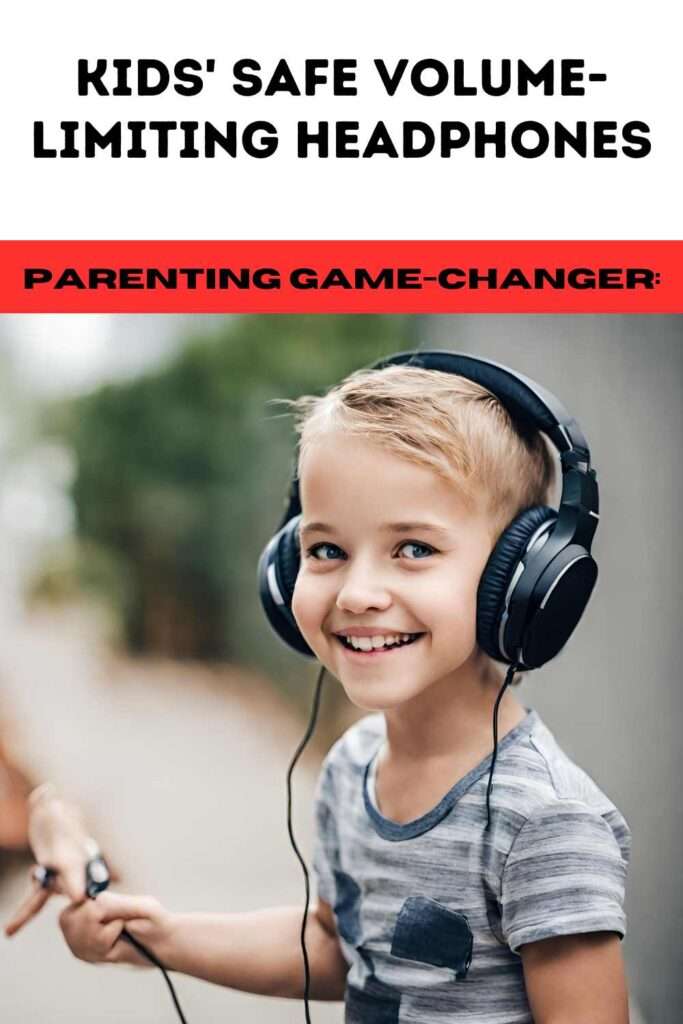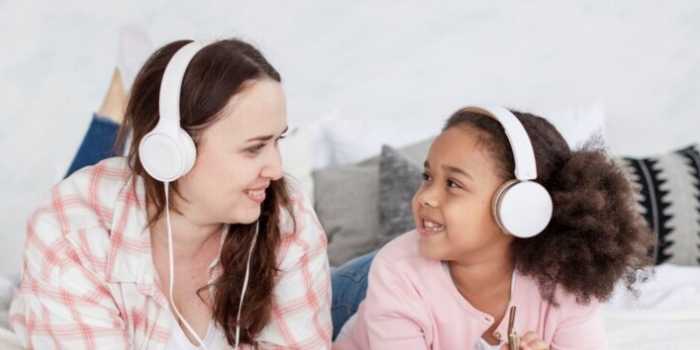In the current digital era, technology has permeated every aspect of children’s lives. With the help of educational apps, interactive games, and streaming content, children are constantly occupied with a variety of audio devices like smartphones, tablets, and laptops.
These gadgets offer excellent opportunities for learning and entertainment, but they also pose a serious threat to young children’s hearing health.
Children’s ears are particularly prone to damage from exposure to loud noises. Long-term exposure to loud music can result in auditory problems like permanent hearing loss.
We must prioritize our children’s hearing health as parents and caregivers and take precautions to keep them safe.
“Kids’ Safe Volume-Limiting Headphones” is a crucial remedy that has surfaced to address this issue.
These specially created headphones use cutting-edge technology to limit the maximum volume output, ensuring that sound levels never get too loud for young ears.
This blog will act as a thorough instruction manual to help parents and guardians comprehend the benefits of using volume-limiting headphones as well as the significance of providing hearing protection for kids.
We’ll examine how these headphones function, what to look for when choosing a set, and how to teach kids responsible usage practices.
Additionally, we will dispel common misconceptions and myths about volume-limiting headphones and offer suggestions for the top options available.
By the end of this post, readers will be able to make decisions for their kids with confidence and a clear understanding of why safe volume-limiting headphones for kids are an important investment in their wellbeing. Let’s set out on this journey to safeguard our kids’ hearing and give them better, safer audio experiences.
The Ultimate Guide to Safe Volume-limiting Headphones
In this topic we will cover:-
- Understanding the Dangers of Loud Audio for Children
- The Role of Volume-Limiting Headphones in Hearing Protection
- Key Features to Look for in Kids’ Safe Volume-Limiting Headphones
- Recommended Kids’ Safe Volume-Limiting Headphones
- Tips for Ensuring Proper Use of Volume-Limiting Headphones
1. Understanding the Dangers of Loud Audio for Children

A. The Vulnerability of Children’s Ears to Loud Sounds
Due to their developing ears, children are more susceptible to hearing loss from loud noises.
Hair cells and other delicate hearing structures like the cochlea are still developing in young children.
Their ears are consequently less adept at processing sound, making them more susceptible to long-term harm from excessive noise exposure.
B. Potential Long-term Consequences of Hearing Damage in Kids
Loud noises cause irreversible hearing loss. Once damaged, the inner ear’s delicate structures are irreparably lost.
Children who experience this may have severe hearing impairments, which may have an impact on their ability to learn new languages, perform well in school, interact socially, and generally lead fulfilling lives.
Additionally, untreated hearing loss can hinder a child’s emotional and cognitive growth and lead to communication problems.
C. Common Sources of Excessive Noise Exposure in Children
There are numerous sources of loud sounds in a child’s environment, some of which may be hidden. Among these sources are:
Personal Audio Devices: Listening to music or watching videos at high volumes with headphones or earbuds can be hazardous to young ears.
Electronic Toys: Some electronic toys emit loud and continuous sounds that can potentially harm a child’s hearing if used for an extended period of time.
Loud Noises: Places such as concerts, sporting events, and amusement parks can expose children to loud noises that exceed safe decibel levels.
Household appliances such as vacuum cleaners, blenders, and hair dryers can emit loud sounds that can harm young ears, especially if used close to the child.
Fireworks and Explosive Noises: Fireworks displays and other explosive noises during celebrations can pose a risk to children’s hearing health.
It is crucial for parents and other adults who look after children to be aware of potential sources of excessive noise and to take precautions to safeguard the ears of the young ones.
It is effective to regulate sound levels and give our kids a safer listening experience by using Kids’ Safe Volume-Limiting Headphones.
2. The Role of Volume-Limiting Headphones in Hearing Protection

A. How Volume-Limiting Headphones Work
Volume-limiting headphones are created specifically to control the maximum volume output, ensuring that sound levels never rise above those that are suitable for children.
The audio level is automatically limited by built-in technology in these headphones to prevent it from rising to potentially harmful decibel levels.
The World Health Organization’s (WHO) recommendation of 85 decibels (dB) for an eight-hour exposure is one example of a recognized safety standard that is typically followed by volume-limiting headphones.
Parents can even set volume restrictions for some headphones based on the age and sensitivity of their child.
B. Advantages of Using Volume-Limiting Headphones for Kids
Hearing Protection: Children’s hearing health is the main advantage of volume-limiting headphones. By preventing excessive volume levels, these headphones significantly lower the risk of hearing damage brought on by prolonged exposure to loud audio.
Volume-Limiting Headphones: With volume-limiting headphones, the varying hearing sensitivity of various age groups is taken into account. They maintain the sound level at a level that is safe and comfortable for a child’s developing ears.
Even when they are not directly supervising them, parents can rest easy knowing that their kids are using audio devices responsibly and safely. The knowledge that the headphones have a volume cap allays worries about possible hearing harm.
Better Focus: By turning up the volume to the right level, kids can focus on their audio content without being distracted by outside noise. This is helpful when using learning apps or audiobooks for educational purposes.
C. Finding the Right Volume Limit for Different Age Groups
The level of sensitivity to loud noises varies with age. When choosing volume-limiting headphones, it is critical to consider the optimal volume levels for various age groups:
Toddlers and preschoolers aged 2 to 5 For this age group, headphones with a maximum volume of about 75 dB are recommended. Because their developing ears are so sensitive, it’s critical to keep the volume low to avoid any potential harm.
School-Age Children (Ages 6-12): Children in this age range should wear headphones with a maximum volume of 85 decibels. Although their ears are still sensitive, they can tolerate slightly higher volumes at this point.
Teenagers (Ages 13-18): Teenagers may wear headphones with a maximum volume of 85-90 decibels. Despite the fact that their ears are more developed than those of younger children, it is still important to exercise caution and keep volume levels at a safe level.
3. Key Features to Look for in Kids’ Safe Volume-Limiting Headphones

There are several important features to consider when selecting the best kids’ safe volume-limiting headphones.
These features ensure that the headphones provide effective hearing protection while also providing children with a comfortable and enjoyable listening experience. Here are some important things to look for:
A. Volume-Limiting Capabilities and Standards
Check that the headphones adhere to accepted safety standards for the highest volume levels, such as the WHO’s recommendation of 85 dB for an eight-hour exposure.
Look for headphones with adjustable volume limits so that parents can change them in accordance with their child’s age and sensitivity. Each child will have a unique and appropriate listening experience thanks to customization.
B. Comfort and Design Considerations for Young Users
Headphones with an Adjustable Headband: Choose headphones with an adjustable headband to accommodate children of varying ages and head sizes. A comfortable fit is essential for prolonged use without discomfort.
Soft Ear Cushions: Choose headphones with soft, padded ear cushions for a more comfortable fit and to relieve pressure on the ears during long listening sessions.
Children’s headphones should be lightweight and durable to avoid strain on their neck and head. Look for materials that are durable and can withstand rough handling by active children.
C. Durability and Safety Features for Active Children
Tangle-Free Cables: Choose headphones with tangle-free or detachable cables to avoid accidents and potential headphone damage.
Built-in Volume-Limiting Mechanism: Make sure the volume-limiting function is built into the headphones and not reliant on additional apps or external devices that children could manipulate.
Noise Isolation: Consider using noise-cancelling headphones to reduce outside noises, allowing children to listen at lower volumes without making too much noise.
D. Connectivity Options and Compatibility
Choose between wired and wireless headphones, taking into account the child’s preferences and the ease of use in various situations.
Universal Compatibility: Make sure the headphones work with a variety of audio devices, such as smartphones, tablets, computers, and gaming consoles.
E. Child-Friendly Designs and Colors
Look for headphones with child-friendly designs, colors, and themes to appeal to children’s interests and make the listening experience enjoyable.
Simple and intuitive controls: Choose headphones with simple and intuitive controls that children can use without adult assistance.
4. Recommended Kids’ Safe Volume-Limiting Headphones
1. Puro Sound Labs:
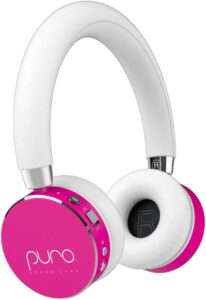
Puro Sound Labs is a reputable brand known for its dedication to safe listening. They offer a range of volume-limiting headphones designed specifically for children. Puro Sound Labs headphones are known for their comfortable fit, excellent sound quality, and strict adherence to safe volume levels.
Features
- Volume Limiting Technology: Puro Sound Labs’ products come equipped with volume-limiting technology to ensure safe listening levels, protecting users’ hearing from potential damage caused by loud audio.
- Healthy Ears® Sound Signature: They use their proprietary “Healthy Ears®” sound signature, which maintains a clear and rich audio experience while keeping the volume at safe levels.
- Kid-Friendly Designs: Puro Sound Labs specializes in creating child-friendly audio products with colorful designs and comfortable, adjustable headbands suitable for different age groups.
- Wireless Connectivity: Many of their products offer wireless connectivity options like Bluetooth, making them convenient and compatible with various devices.
- Long Battery Life: Puro Sound Labs’ products often boast extended battery life, ensuring extended listening sessions without frequent recharging.
- Noise Isolation: Their headphones are designed to passively block out external noise, allowing users to enjoy their audio without distractions.
Pros:
- Hearing Protection: Puro Sound Labs specializes in creating headphones with volume-limiting technology, protecting users from excessive sound exposure and potential hearing damage, especially important for children and teenagers.
- Sound Quality: Despite the volume-limiting feature, Puro Sound Labs products still deliver impressive audio quality, providing a balanced and enjoyable listening experience.
- Comfortable Design: The headphones are designed with comfort in mind, often featuring adjustable headbands and soft ear cushions for extended wear.
- Wireless Options: Puro Sound Labs offers wireless headphone models, providing convenience and freedom of movement without compromising on hearing protection.
- Durability: The headphones are constructed with durable materials, making them suitable for active use and resistant to wear and tear.
Cons:
- Limited Volume: While the volume-limiting feature is a safety measure, some users may find the maximum volume restriction too conservative, leading to reduced sound levels compared to other headphones.
- Price: Puro Sound Labs products can be relatively more expensive compared to non-volume limited alternatives, possibly deterring budget-conscious consumers.
- Limited Features: Some users might miss advanced features such as active noise cancellation or touch controls found in other premium headphone brands.
2. BuddyPhones:
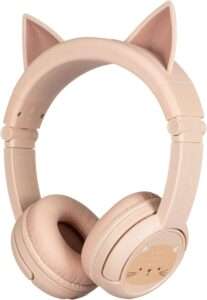
BuddyPhones has a wide range of volume-limiting headphones for children of all ages. They offer various models with various features, such as wired and wireless options, adjustable volume limits, and durable designs suitable for active children.
Features
- Volume Limiting: BuddyPhones come with built-in volume limiting technology, which prevents the audio level from exceeding safe limits to protect children’s sensitive ears from potential hearing damage.
- Kid-Friendly Design: These headphones feature a durable, child-friendly construction with soft, comfortable padding and adjustable headbands suitable for different age groups.
- Sharing Port: Some BuddyPhones models include a “BuddyCable” sharing port that allows multiple headphones to be connected together, making it easy for kids to share their audio with friends during group activities.
- Built-in Microphone: Certain BuddyPhones variants are equipped with a built-in microphone, enabling children to use them for video calls, virtual learning, or voice interaction with devices.
- Foldable and Portable: BuddyPhones are designed to be easily foldable and portable, making them convenient for travel and storage.
- Long Battery Life: Many BuddyPhones models offer extended battery life, allowing for prolonged use before requiring recharging.
Pros
- Child-friendly design: BuddyPhones are specifically designed for children, featuring attractive colors and fun themes that appeal to kids.
- Volume-limiting technology: They incorporate built-in volume-limiting technology to protect children’s delicate ears from excessive sound exposure, preventing hearing damage.
- Durable and adjustable: These headphones are made with sturdy materials, ensuring they can withstand rough handling by children. Additionally, they usually have adjustable headbands to accommodate various head sizes.
- Shareable audio: Some BuddyPhones models come with a “BuddyCable” feature, allowing multiple headphones to be connected to a single audio source, facilitating shared listening experiences.
- Foldable and portable: Many BuddyPhones models are foldable, making them easy to store and carry while traveling or on the go.
Cons
- Limited volume range: While the volume-limiting technology is a safety feature, it may result in reduced maximum volume, making it less suitable for adults or older kids who prefer louder audio.
- Sound leakage: Some models may experience sound leakage, which could be bothersome to people nearby, especially in quiet environments.
- Comfort issues: While they are adjustable, some users may find the ear pads less comfortable for extended use.
3. JBL JR:
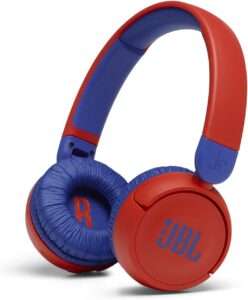
JBL’s JR series is designed with kids’ safety in mind. These headphones come with built-in volume limiting technology and feature fun and vibrant designs to appeal to young users.
Features
- Designed for Kids: Kid-friendly design with colorful and playful aesthetics.
- Safe Volume Limit: Built-in volume limiter to protect children’s ears from loud sounds.
- Durable Build: Sturdy construction to withstand rough handling by kids.
- Comfortable Fit: Adjustable headband and soft ear cushions for comfortable wearing.
- Wireless Connectivity: Bluetooth connectivity for easy pairing with devices.
- Long Battery Life: Extended battery life to last through hours of playtime.
- Fun Stickers: May include stickers for kids to personalize their headphones.
Pros:
- Child-friendly design: JBL JR products are specifically designed to be durable and appealing to children with fun colors and playful designs.
- Volume limiting: Many JBL JR products come with built-in volume limiting features to protect children’s hearing and ensure safe listening levels.
- Lightweight and comfortable: The headphones in the JBL JR series are typically lightweight and have soft cushioning for comfortable use, even during extended listening sessions.
- Wireless options: Some JBL JR products offer wireless connectivity, which can provide more freedom of movement for children during use.
Cons:
- Limited features: The JBL JR series is primarily designed for kids, so it may lack advanced features available in other JBL products meant for adults.
- Smaller size: The size and fit might not be suitable for older children or adults, limiting the longevity of the product’s usefulness.
- Price: Compared to generic children’s headphones, JBL JR products may be relatively more expensive, which could be a drawback for some parents.
4. LilGadgets:
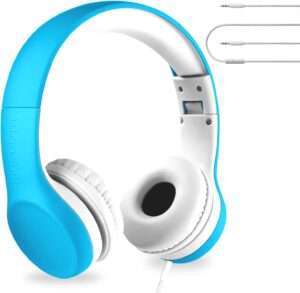
Another company that focuses on providing secure listening options for children is called LilGadgets.
Their headphones are built to last, are comfortable to wear, and come with volume-limiting features that are designed to keep children’s hearing safe.
Features:
The BuddyPhones PlayEars+ headphones have a number of programmable features that can be adjusted to suit a child’s developmental stage, surrounding conditions, and personal preferences.
- They have three different modes available:
- TravelMode (maximum 94dB),
- KidsMode (85dB),
- ToddlerMode (75dB),
They can be used on a variety of modes of transportation, including trains, planes, and cars, because they are each equipped with a safety mechanism that can be adjusted to quiet, normal, and loud settings.
The dual connection capability of these headphones allows for both wireless and wired use, ensuring that kids can still enjoy music or videos even when the battery is running low.
pros
- Child-friendly design:.
- Volume limiting:
- Lightweight and comfortable:
- Wireless options:
Cons:
- Limited features:
- Smaller size:
- Price:
5. MEE Audio KidJamz:
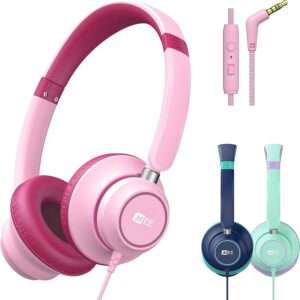
MEE Audio has a line of headphones called KidJamz that are designed specifically for young listeners and offer appropriate volume levels. They are well-known for having a comfortable fit and controls that are simple to operate.
Features
- Designed for kids: Kid-friendly design with bright colors, playful patterns, and smaller headband sizes for comfortable wear by children.
- Volume-limiting: Built-in volume limiter to protect children’s ears from excessive noise and prevent hearing damage.
- Durable construction: Sturdy materials and reinforced cables to withstand rough handling and ensure longevity.
- Safe materials: Made with non-toxic materials and hypoallergenic components to ensure safety and comfort for children.
- Tangle-resistant cables: Special cable design to minimize tangling and make it easier for kids to use and handle.
- Kid-proof controls: Simplified control buttons that are easy for children to use, promoting independence.
- Fun accessories: Some kid’s headphones may come with stickers or other customizable elements, allowing children to personalize their headphones.
Pros:
- Designed for Kids: Kid-friendly design with a smaller size and comfortable fit for children’s ears.
- Volume-Limited: Built-in volume limiter to protect children’s hearing from excessive noise levels.
- Durable Build: Sturdy construction and materials to withstand rough handling by kids.
- Fun Colors: Attractive color options that appeal to children and add a playful touch.
- Lightweight: Easy for kids to wear for extended periods without discomfort.
- Safe for Young Ears: Kid-safe audio levels prevent potential hearing damage.
- Affordable: Reasonably priced for a kids’ headphone, making it accessible to a broader audience.
- Ideal for Travel: Compact size and foldable design make them suitable for travel and storage.
Cons:
- Limited Features: May lack some advanced features found in higher-end headphones.
- Sound Quality: While good for kids, the audio quality may not match high-end headphones.
- Durability: While sturdy, they might not be as durable as some more expensive options.
5. Tips for Ensuring Proper Use of Volume-Limiting Headphones
The effectiveness of volume-limiting headphones for protecting children’s hearing depends on proper use and supervision.
Parents and other responsible adults should remember the following guidelines when using volume-limiting headphones:
How to Teach Children to Listen Safely:
Remind them of the need to protect their hearing and the potential risks of watching or listening to loud music or videos.
Teach them to adjust the volume if they begin to feel uncomfortable or exhausted and to recognize when it is too loud.
Set Appropriate Volume Levels:
Take the child’s age and hearing sensitivity into consideration when setting the volume limits on the headphones.
Set the volume limit lower for younger kids and then gradually raise it as they get older.
Use caution around young children when using headphones, especially if they plan to listen to audio for an extended period of time.
Check the headphones’ volume settings frequently to make sure they stay within the safe range.
Encourage Breaks and Set Time Limits:
To give kids’ ears a break from using headphones, encourage them to take regular breaks.
To lower the risk of overexposure, limit the total amount of time each day that they spend wearing headphones.
Model Conduct yourself in a manner that exemplifies responsible listening, such as using speakers or headphones with volume controls when sharing audio content with your child.
Use Open-Back or Bone Conduction Headphones:
For younger children, think about using open-back or bone conduction headphones. These headphones lessen the isolation effect by allowing some outside sound to be heard.
Teach Children Safe Listening Outside of Headphone Use: Inform kids about the risks associated with loud noises outside of headphone use, such as at sporting events, concerts, and fireworks displays.
Encourage communication by telling kids to speak up if they have trouble hearing or are uncomfortable while wearing headphones.
Maintain Device Updates:
Make sure the volume control features and software on the devices kids use with their headphones are up to date.
Changes to Monitor Device Volume:
Examine the volume controls on any audio devices (computers, tablets, and smartphones) that kids use while wearing headphones. To prevent unexpectedly loud sounds, turn down the device volume before putting on the headphones.
Conclusion
It has never been more important to protect children’s hearing in a time when technology plays an ever-growing role in their lives.
Safe volume-limiting headphones for children offer a practical way to protect developing ears from the dangers of exposure to excessive noise.
These headphones guarantee that kids can enjoy their audio experiences without endangering their hearing health by limiting the maximum volume output and adhering to accepted safety standards.
Frequently asked questions
What are volume-limiting headphones, and how do they work?
Volume-limiting headphones are specially designed to cap the maximum volume output, ensuring that sound levels never exceed safe thresholds for children. They incorporate built-in technology that automatically restricts the audio level to protect young ears from excessive noise exposure.
Are volume-limiting headphones effective in protecting children’s hearing?
Yes, when used correctly, volume-limiting headphones are highly effective in safeguarding children’s hearing. They comply with recognized safety standards and help prevent potential hearing damage caused by prolonged exposure to loud audio.
